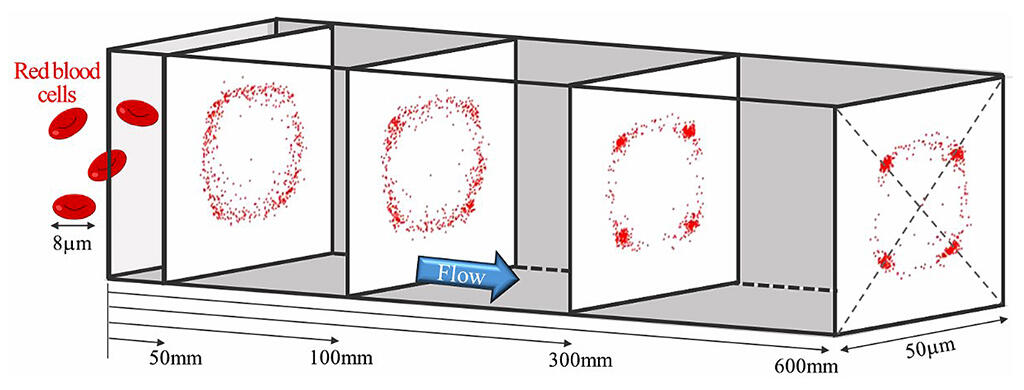A research group led by Professor Masako Seki of the Faculty of Engineering Science, Kansai University, has developed an experimental system that observes the cross section of the outlet of microtubules making it possible to obtain precise particle distributions by measuring the position of floating particles with high precision.

Provided by Professor Masako Seki, Kansai University
When a particle suspension is poured into a straight pipe, the particles are expected to move straight into the flow. In reality, however, suspended particles that experience inertial lift from the flow also move laterally and pass specific locations in the downstream pipe cross section. The research group experimented with red blood cells as suspended particles. At rest, red blood cells are disk-shaped with a diameter of 8 µm and a thickness of about 2 µm and are highly deformable. The research group determined the distribution of red blood cells in a cross-section at various flow velocities by flowing dilute suspended red blood cell fluid through square capillary tubes and measuring the position of the blood cells in the downstream cross-section.
The intra-sectional distribution of rigid spherical particles suspended in spherical plasma indicated the presence of elasticity in the plasma, which may affect the behavior of red blood cells. The group confirmed the concentration at the center of the tube when the flow was slow and found for the first time that the red blood cells migrate and concentrate at four points on the diagonal of the tube when the flow velocity increased. Rigid spherical particles of approximately the same size spread over the entire cross-section with little lift at low velocities, in contrast to gathering near the center of each side as velocity increased. Experiments using sclerotic red blood cells whose deformability was degraded by drugs confirmed that this difference in distribution is primarily due to the deformability of the suspended particles.
Furthermore, the difference in the distribution of rigid spherical particles when plasma and Newtonian fluid were used as the medium indicated the plasma had elasticity, which may affect the behavior of red blood cells.
The results of this research were published in the August issue of the Journal of the Physical Society of Japan, an English-language journal published by the Physical Society of Japan.
"Our research shows it is possible to detect and sort red blood cells and other cells according to their deformability," says Professor Seki. "We can use microfluidic devices to diagnose various diseases and monitor medical conditions."
Originally published in JPS Hot Topics 2, 033 (2022). (https://doi.org/10.7566/JPSHT.2.033)
This article has been translated by JST with permission from The Science News Ltd.(https://sci-news.co.jp/). Unauthorized reproduction of the article and photographs is prohibited.




